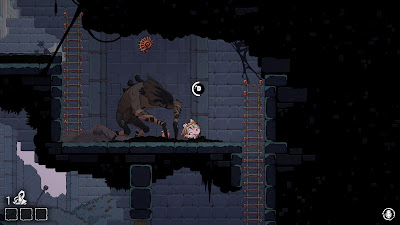Well this looks familiar
Yes, I pretty much did no research on any of the demos that I downloaded, all on the off chance that I might get something good, which did lead to a bit of fumbling with the sorts of games that I would never usually play if given the option. Games far outside my typical pick of genres. (So basically just any game which isn't an RPG.) I'm picked up a simply stupid amount of RPGs over the past few weeks further hammering home the point that I can get a bit monogamous when left to my own devices without something to challenge me, so I think it was good to saddle up to different types of games here and there. As for the two games I played through and am covering in this blog, not only are they both genres that I wouldn't have expected to play on my own, they are both games that I'm going to consider under the category of 'like this other game' for clarities sake.
The first of which is Riftbound, a game which features so much nature themed character designs and imagery that you just might get sick of the colour green if you spend too long starring at it's endless moss strewn stages. Honestly I think the game looks somewhat pretty and has a charm to it's presentation, but once again I have a feeling that the 3D models aren't to a standard of quality that suits the robust mechanics of the game. As in, when I first saw these models, they had me worried about if I was going to play something that was readily realised. Now I'm speculating here, but I think the reason for that may be because the designs of the various sprites and elemental spirits that populate this world where drawn up first on a 2D space, for the game's art, and then translated into 3D, which meant a lot of characters who are too round or plastic-y to work in a 3D world. But enough talking about models, what about the game?
And then we have 'After Shadows'. Another title in the 'I like the logo so I'm just going to download this' area of demo exploration. (Let that be a lesson to those who don't know it yet; cool logos do wonders for discoverability) What I discovered this time was a 2d platformer set to a somewhat pretty dark fantasy world space, and my initial thoughts were 'finally, a cool adventure platformer, this is the sort of stuff I expected more of.' Only I was dead wrong, on the adventuring part, not the platforming. Because this is a game that suffers quite a bit from it's lack of tutorial, in that even after a mostly complete session I've only come away with a somewhat decent idea of what the creator was going for on this title. (But I think I've got it.)
So for story reasons that I don't care to go into, the game requires the 'syncing' of several crystals or something, it's not important. What is important, is that the syncing of these nodes takes time and activates a minigame with the odd random quicktime event in order for the progress bar to keeping going to completion. Getting in the way of finding and syncing these crystals is a black goo monster who occasionally spawns out of the ground, jumps up and attacks you. There's no way to fight back, only hiding spots to cower within, and if he does hit, you'll be treated to another quick-time event in order to escape. Do you see where I'm going with this? What sort of game this one is like? It took me way too long to figure it out myself but here it is: this is essentially a 2D single player platforming version of Dead by Daylight.
The very idea of 'What about this but with that' is integral to a lot of coolest ideas in art, and so I'm happy when we see these sorts of games that can reimagine the familiar, but it's never an easy task to create something new, and even more so from established elements. Neither of the two games I played felt like they had 'lightning in a bottle' so to speak, but both had the promise of creators who wanted to think a little bit of the box, and that goes a long way when you know how to use it. So these are the sorts of games I would classify as promising, whilst wanting. Not the highlights of the fest perhaps, but maybe the beginnings of future success stories, or just development careers that may be going places. These are games that I'm glad I'm played.








No comments:
Post a Comment